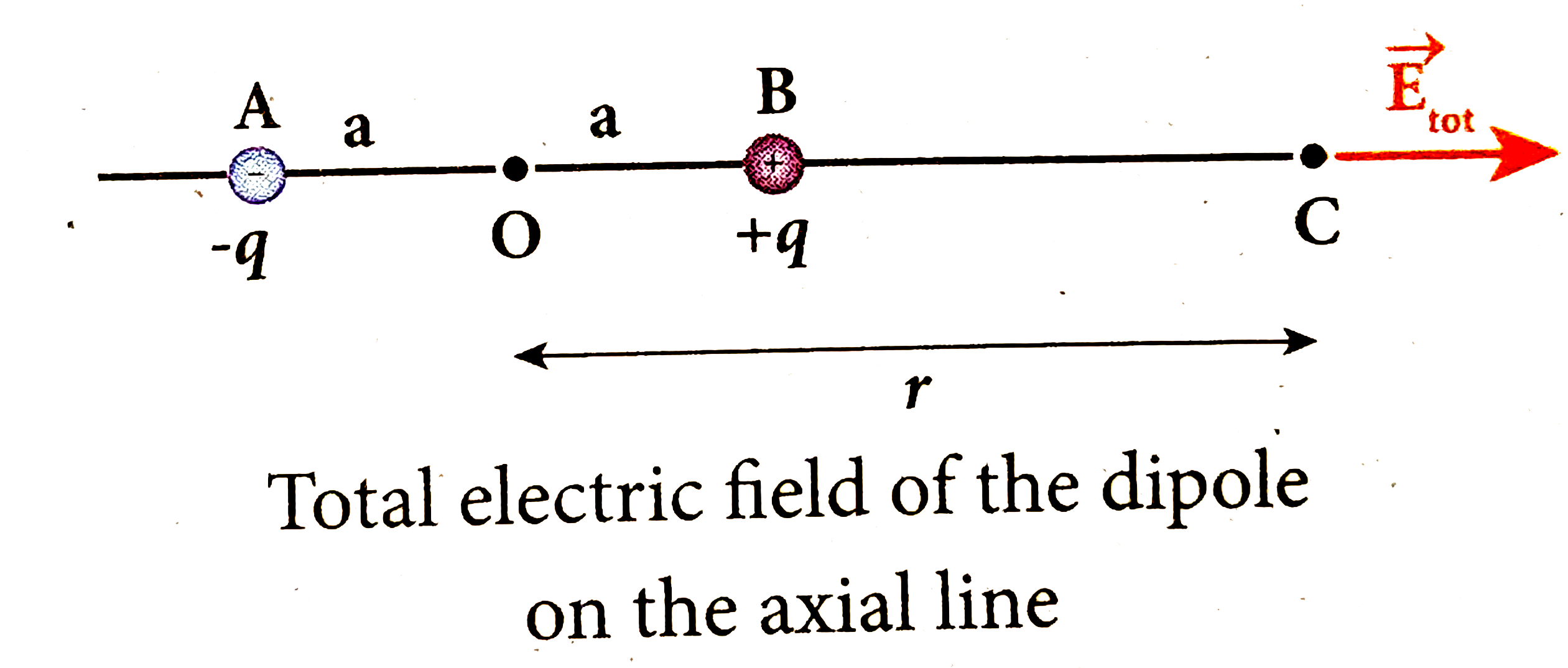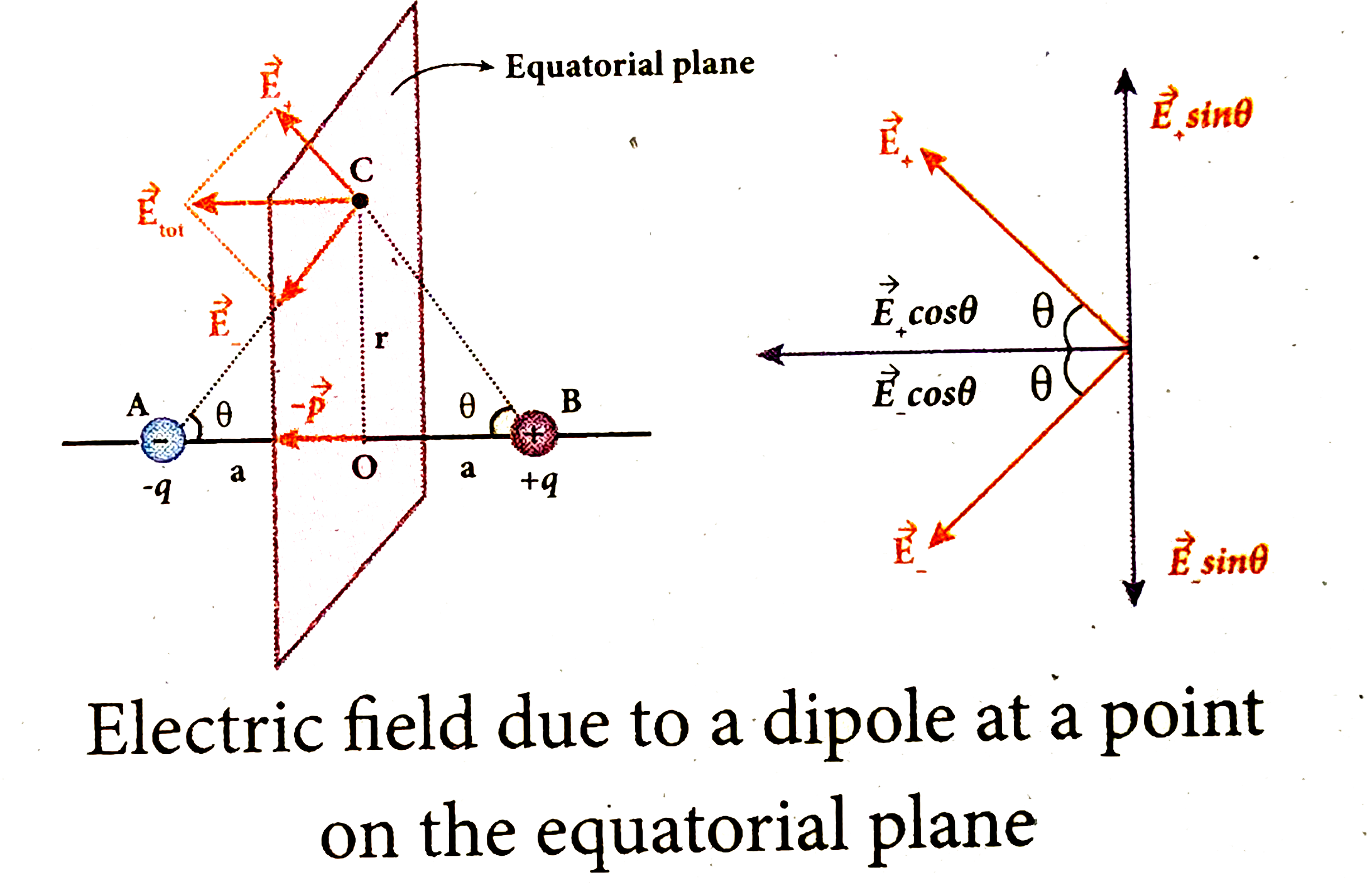Calculate the electric field due to a dipole on its axial line and equatorial plane. Solution in Tamil
Electric field due to an electric dipole at points on the axial line : Consider an electric dipole placed on the x-axis. A point C is located at a distance of r from the midpoint O (of the dipole) along the axial line.
The eletctric field at a point C due to +q is
→E=14πε0q(r−a)2 along BC
Since the electric dipole moment vector →p is from -q to +q and is directed along BC, the above equation is rewritten as
→E=14πε0q(r−a)2ˆp .......(1)
where →p is the electric dipole moment unit vector from -q to +q. The electric field at a point C due to -q is
→E=−14πε0q(r+a)2ˆp .......(2)
Since +q is located closer to the point C than −q,→E+ is stronger tham →E−. Therefore, the length of the →E+ vector is drawn larger than that of →E− vector.
The total electric field at point C is calculated using the superposition principle of the electric field.
→Etot=→E++→E−
=14πε0q(r−a)2ˆp−14πε0q(r+a)2ˆp ......(3)
→Etot=q4πε0(1(r−a)2−1(r+a)2)ˆp .......(4)
→Etot=14πε0q(4ra(r2−a2))ˆp ......(5)
Note that the total electric field is along →E+ since +q is closer to C than -q.
If the point C is very far away from the dipole then (r>>a). Under this limit the term (r2−a2)≈r2. Substituting this
→Etot=14πε0(4aqr3)ˆp(r>>a)
Since 2aqˆp=→p
→Etot=14πε2→pr3(r>>a) ......(6)
The direction of →Etot is shown in Figure.

Total electric of the dipole on the axial line
If the point C is chosen on the left side of the dipole, the total electric field is still in the direction of →p.

Electric field due to to dipole at a point on the equatorial plane
Electric field due to an electric dipole at a point on the equatroial plane :
Consider a point C at a distance r from the midpoint O of the dipole on the equatorial plane.
(ii) Since the point C is equi-distant from +q and -q, the magnitude of the electric fields of +q and -q are the same. The direction of →E+ is along BC and the direction of →E− is along CA. →E+and→E− are resolved into two components, one component parallel to the dipole axis and the other perpendicular to it. The perpendicular components ∣∣→E+∣∣sinθand∣∣→E−∣∣sinθ are oppositely directed and cancel each other. The magnitude of the total electric field at point C is the sum of the parallel components of →E+and→E− and its direction is along -p as shown in the Figure.
→Etot=∣∣→E+∣∣cosθˆp−∣∣→E−∣∣cosθˆp ......(1)
The magnitudes →E+and→E− are the same and are given by
∣∣→E+∣∣=∣∣→E−∣∣=14πε0=q(r2+a2) .......(2)
By substituting equation (2) into equation (1), we get
→Etot=14πε02qcosθ(r2+a2)ˆp
=14πε02qcosθ(r2+a2)32ˆp
Since cosθ=a√r2+a2
→Etot=14πε0→p(r2+a2)32
since →p=2qaˆp .......(3)
At very large distances (r>>a), the equation (3) becomes
→Etot=−14πε0→pr3 (r>>a)
(iii) The magnitude of the electric field at points on the dipole axis is twice the magnitude of the electric field at points on the equatorial plane. The direction of the electric field at points on the dipole axis is directed along the driection of dipole moment vector −→p but at points on the equatorial plane it is directed oppsite to the dipole moment vector, that is along −→p .
(iv) At very large distances, the electric field due to a dipole varies as 1r3 for a point charge, the electric field varies as 1r2. Electric field due to a dipole at very large distances E goes to zero faster than the electric field due to a point charge.
(v) →E=14πε0→pr3 valid only at very large distances (r>>a).
Similar Questions
If Ea be the electric field strength of a short dipole at a point on its axial line and Ee that on the equatorial line at the same distance, then
03:56View SolutionIf E1 is the electric field strength of a short dipole on its axial line and E2 that on the equatorial line at the same distance, then
04:12View SolutionElectric Field Due to Dipole-Axial and Equatorial Position||Electric Potential Due to Dipole - Axial and Equatorial Position||E and V Due to a Dipole at a General Point
54:59View SolutionElectric Dipole#!#Electric Field due to an electric dipole on its axial line
42:08View Solutionकिसी विधुत द्विध्रुव के कारण इसकी अक्ष व विषुवतीय तल पर विधुत क्षेत्रो का अनुपात होगा
02:28View SolutionElectric field due to dipole#!#Axial point#!#Equatorial Points
48:49View SolutionThe electric field due to small dipole at a distance r from centre of dipole on axial is E. Find the distance on the equatorial line to have same electric field.
View SolutionIf Ea be the electric field strength due to a short dipole on the axial line and Ee be that on the equatorial line at the same distance from the sane distance from the dipole, then
View Solution

